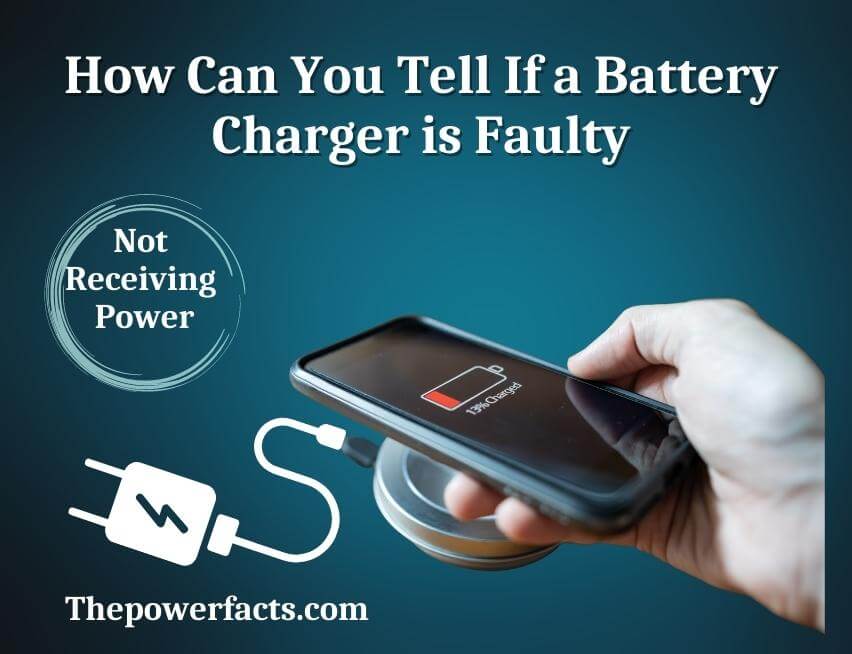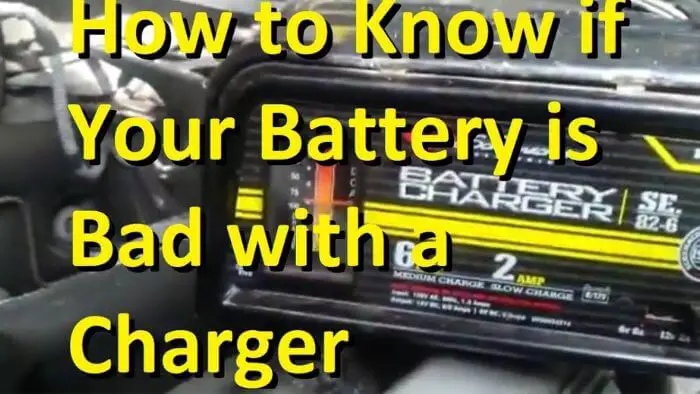There are a few things you can do to test whether or not your battery charger is faulty. First, check to see if the charger is getting power by plugging it into an outlet and testing it with a multimeter. If the charger is not receiving power, then it is likely faulty.
Another way to test the charger is to try charging a known good battery with it. If the battery does not charge or charges slowly, then the charger may be at fault. Finally, if you have access to another battery charger, you can compare the two chargers by testing them side by side.

If one charger significantly outperforms the other, then it is likely that the slower charger is faulty.
If your battery charger is not working properly, there are a few things you can do to test it. First, check the power cord to make sure it is plugged in correctly. Next, check the fuse or circuit breaker to see if it needs to be replaced.
Finally, check the outlet to see if there is power going to it. If none of these things work, then the battery charger is most likely faulty and will need to be replaced.
How Do You Test If a Charger is Working?
If you’re not sure if your charger is working, there are a few things you can do to test it. First, check to make sure that the charger is plugged into an outlet and that the cord is firmly connected to both the charger and your device. If everything looks good there, try plugging your device into another outlet to see if it charges.
If your device still won’t charge, try using a different charging cable or adapter (if you have one).
If none of those things work, then it’s likely that your charger is defective and needs to be replaced.
What Causes a Battery Charger to Stop Working?
If your battery charger isn’t working, there are a few things that could be causing the issue. Here are some of the most common reasons why battery chargers stop working:
1. The Outlet Is Dead
If you’re plugging your charger into an outlet and it’s not working, it could be because the outlet is dead.
Check to see if other electronics will work in the same outlet. If they don’t, then you’ll need to reset the circuit breaker or replace the fuse.
2. The Charger Is Worn Out
Over time, chargers can start to wear out and become less effective.
If your charger is more than a few years old, it might be time for an upgrade.
3. The Battery Is Bad
In some cases, the problem isn’t with the charger at all but with the battery itself. If your battery is old or damaged, it might not be able to hold a charge anymore no matter how good your charger is.
Try replacing the battery to see if that solves the problem.
4. There’s Something Wrong With The Device You’re Charging
In rare cases, there may be an issue with whatever device you’re trying to charge (e.g., a phone, laptop, etc.).
This could mean that there’s a problem with its charging port or something else entirely.
How Do I Test a Battery Charger With a Multimeter?
To test a battery charger with a multimeter, you’ll need to set the multimeter to its DC voltage setting. Then, connect the positive lead of the multimeter to the positive terminal of the battery charger, and connect the negative lead of the multimeter to the negative terminal of the battery charger. Finally, take a reading on the multimeter.
The voltage should be within 10% of the rated voltage of the charger. If it’s not, then there may be something wrong with your charger.
Is There a Fuse in a Battery Charger?
No, there is not a fuse in a battery charger. A battery charger works by supplying power to a battery to recharge it. The charging process is controlled by the charger itself, not by a fuse.
If there was a fuse in the charger, it would be for protection from over-current or short circuits, but it would not affect the charging process itself.

How to Test a Battery Charger to See If It is Charging?
If your battery charger isn’t working, it could be because the charger itself is defective. To test a battery charger and see if it’s charging, you’ll need a voltmeter. First, make sure that the voltmeter is set to measure DC voltage.
Then, connect the positive lead of the voltmeter to the positive terminal of the battery charger, and connect the negative lead of the meter to the negative terminal of the charger. If the voltmeter reading is above 0 volts, then your charger is working and charging the battery.
How to Test a Battery Charger Without a Battery?
If you need to test a battery charger but don’t have a battery handy, there’s an easy way to do it. All you need is a voltmeter.
First, connect the positive lead of the voltmeter to the positive terminal of the charger, and the negative lead of the voltmeter to the negative terminal of the charger.
Then plug in the charger and check the reading on the voltmeter. It should be close to the rated voltage of the charger (usually around 12 volts). If it’s not, then there may be something wrong with your charger.
Next, disconnect the voltmeter and connect its leads directly across the terminals of the battery connector on the charger (again, positive to positive and negative to negative). This time, check for continuity with your multimeter set to Ohms mode. There should be very little resistance – if there is any at all, it means that your charging circuit is probably working correctly.
Now that you know how to test a battery charger without a battery, you can easily troubleshoot any charging problems you may have!
How to Tell If a 12 Volt Battery Charger is Working?
If you’ve ever wondered how to tell if a 12-volt battery charger is working, wonder no more! There are a few simple ways to test whether or not your charger is functioning properly. First, make sure that the charger is plugged into a live outlet and that the charging cord is properly connected to the battery.
Once you’ve done this, check the charging indicator light on the charger. If it’s lit up, then the charger is working. Next, take a look at the voltmeter on the charger.
This should read around 12 volts when the charger is connected and working properly. If it reads anything lower than 12 volts, then there may be an issue with your charger. Finally, disconnect the charger from both the outlet and the battery and then reconnect it.
The charge indicator light should turn back on, and you should see around 12 volts on the voltmeter once again. If not, then there could be a problem with your charger and you’ll need to troubleshoot further or get a new one.
How to Tell If a Battery is Charging?
Batteries are an essential part of many devices, from cell phones to laptops. But how can you tell if a battery is charging? There are a few ways to tell if a battery is charging.
One way is to look at the LED indicator on the charger. If the LED is lit, then the battery is currently charging. Another way to tell if a battery is charging is to check the voltage with a voltmeter.
If the voltage is increasing, then the battery is being charged. If you’re not sure how to use a voltmeter or don’t have one handy, there’s another way to tell if your device’s battery is charging – by using the power button. Most devices will display a different color light when they’re plugged in and actively charging versus when they’re not plugged in and not actively charging.
For example, an iPhone typically shows a green light when it’s plugged in and actively charging, whereas it will show an amber light when it’s not plugged in or isn’t actively charging. So, next time you’re wondering whether or not your device’s battery is charging, just follow these simple steps!
How to Tell If Battery Tender is Charging?
It’s easy to tell if your Battery Tender is charging – just check the LED indicator light. If the light is green, that means your battery is being charged. If the light is red, that means there’s a problem and your battery isn’t being charged.
How Do You Troubleshoot a Battery Charger?
When your battery charger isn’t working, it can be frustrating. Here are some tips on how to troubleshoot a battery charger:
| Check the power source | Make sure that the power source (outlet or batteries) is working properly. |
| Check the connections | Make sure that all of the connections are tight and secure. |
| Check for damage | Inspect the charger for any physical damage, such as cracks or breaks in the casing. If there is damage, you’ll need to replace the charger. |
| Try a different outlet or power source if possible | This will help rule out any issues with the original power source. |
If you follow these steps and still can’t get your battery charger to work, then it’s time to contact customer support for further assistance.
How to Check If Battery is Charging With Multimeter?
If your car battery is dead, you may be able to use a multimeter to test the charging system and see if it’s working. Here’s how:
First, make sure the multimeter is set to the correct setting. For testing a car battery, you’ll want to use the 20-volt DC setting.
Next, connect the red lead of the multimeter to the positive terminal of the battery, and touch the black lead to the negative terminal.
If the reading on the multimeter is 12 volts or higher, that means your charging system is working and your battery is being charged.
In a Nutshell
The average lifespan of a car battery is three to five years, so it’s important to know how to tell if a battery charger is faulty. There are a few signs that can indicate a problem with your charger, such as:
-The charger doesn’t turn on when you plug it in.
-The charger turns on but the light is dim or flickering.
-The charger turns on but the needle doesn’t move. If you notice any of these issues, it’s best to take your charger to a professional for further inspection.
Trying to use a faulty charger could damage your battery or even cause an explosion, so it’s not worth the risk!